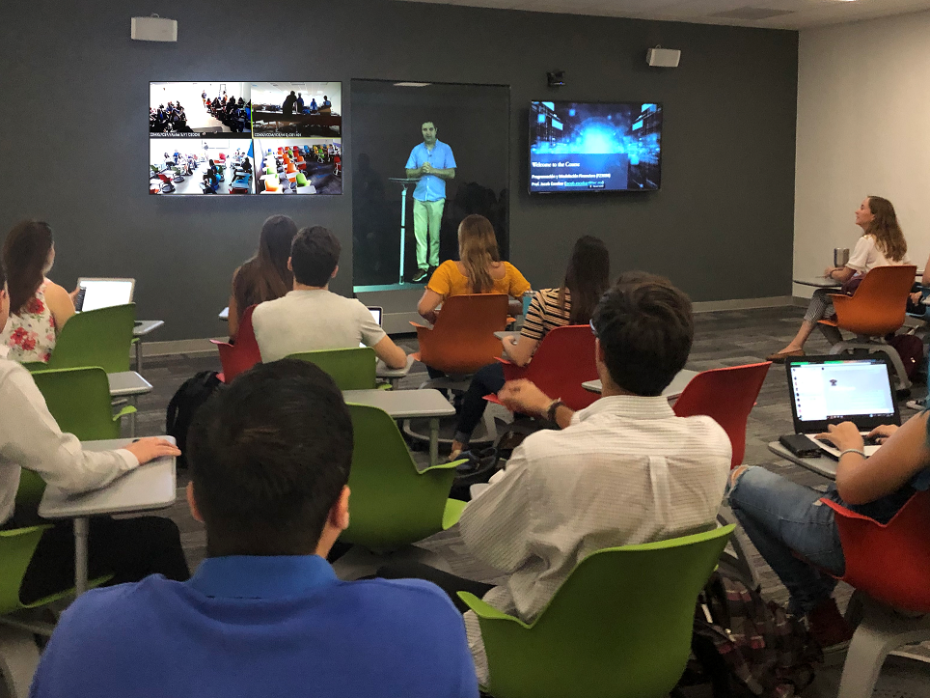You’ve been in classrooms or presentations with people who had “presence.” They walked into the room or on to the stage and they were the centre of attention. People listened to them – they remembered what was said. People followed them afterwards to learn more about whatever they were talking about.
Why? What did they do to get this type of response from participants? And, how can we use these lessons to make students want to engage in their course content and better remember and use what they have learned?
So – what is stage presence?
We may know it when we see it, but how can we define it? “Stage presence refers to the certain charisma and charm that a theatre actor or performer possesses that draws in an audience and commands their full attention,” explains Dallas stage school KD Studio. This “star power” or “charisma” isn’t something that most of us are taught in graduate school. But when we look at how to focus our students on learning and how to engage them with the material, this idea of “stage presence” can help focus students’ attention on what we want them to remember.
- THE Campus collection: rethinking lectures for a digital age
- In defence of old-school teaching during a worldwide crisis
- How to create human connection when teaching online
Now, I know what you’re probably thinking: “The material that I teach is so important that it shouldn’t matter how it is presented.” And you are partially right. Higher education isn’t about “star quality” or “entertainment”. But it is about engaging students with what we want them to learn – and if using a few techniques from outside higher education will help improve student learning, I’m fine with that.
Techniques to enhance presence
If you’re in a classroom and will be teaching students face to face, go and sit in the back of the room and take a look at what the front of the classroom looks like. If you’re in a large lecture hall, you may be surprised by how far away the students are when they sit back there. It’s hard to be the focus of their attention if they can’t really see you, or your slides.
If you’re teaching online, consider carefully how you and your presentation will look to your students. Many don’t have big monitors and may be viewing your lecture on their phone.
1. Think about how your students will hear you
What is the volume that you need to project in order to be heard at the back of the room or through the online medium? You probably need to be louder than you think. Enunciate your words. Don’t let the ends of your sentences get softer so that only the first few rows hear what you say. Nothing will lose your students’ attention faster than not being able to hear what is being discussed.
2. Think about the visuals
What are you showing? Is it only words on your slides? Will an image better share your point? Students tend to write down the words on the slides (or just print them and not pay attention), but when you show a picture and talk about it, you may gain their focus and attention, which may lead to better learning.
3. Find a ‘bright spot’ in each class
This is something that you will look forward to discussing or showing. You don’t even need to tell your students what your “bright spot” is for any lecture (or even that you have one). But if there is always something that you’re looking forward to sharing, that excitement will be communicated to your students. They’ll know.
4. Care about your students and their learning
And care about what you are teaching. When students can see that you deeply care about what you are teaching, they may find a way to care more about it, too. Why is it important? Why do they need to know that particular theory? If you can’t answer that, you probably don’t care much about it, either. By showing your students that you care about what they are learning and that they are learning, you are making them realise they are important to you, even in the aggregate. That will make them better engage with your class.
5. Don’t be afraid to use ‘showmanship’
As The Musician’s Way author Gerald Klickstein says: “Showmanship (or show-womanship) entails projecting our love of music and our desire to commune with listeners. It doesn’t equate with flamboyance. Whenever we’re on stage, whether we’re performing for the public or an audition panel, our demeanour, gestures and speech should broadcast an invitation that says: ‘Let’s share something magical!’”
Teaching is magical – and when our students can see that, they will engage with you and with the course content.
Engaging our students doesn’t mean that we have to become entertainers or that we have to make things easy. What we do have to do is to show how important what we’re teaching is to us and that we’re passionate about it. When we care about what we’re teaching and we care that students learn, we can embrace new ways to bring content into the classroom. We can use discussions, case studies, group work and more to find the best way to connect with students so that they care about what is taught as much as we do.
Catherine M. Wehlburg is provost and vice-president for academic affairs at Athens State University.
If you would like advice and insight from academics and university staff delivered direct to your inbox each week, sign up for the Campus newsletter.




comment